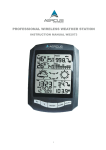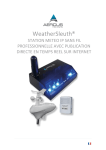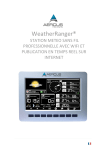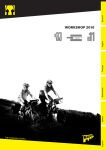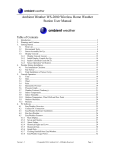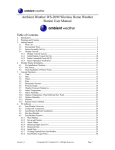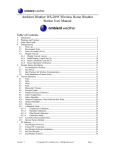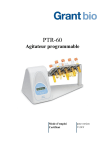Download Aercus WS3083 Installation guide
Transcript
WS3083 PROFESSIONAL WIRELESS WEATHER STATION WITH USB UPLOAD, UV INDEX & LIGHT METER WS3083 -1- WS3083 PROFESSIONAL WIRELESS WEATHER STATION WITH USB UPLOAD, UV INDEX & LIGHT METER Operation Manual About This Manual Thank you and congratulations on selecting this professional weather station. We are positive you will enjoy the benefits of accurate weather readings and information that our weather stations offer. This manual will guide you step-by-step through setting up your device. Use this manual to become familiar with your professional weather station, and save it for future reference. Important! Warranty and Support We warrant our products to be free of defects in components and workmanship, under normal use and service, for one year from the date of original purchase. For product support and warranty claims please contact the following: Purchased in UK/EU: As many issues can be a result of incorrect setup please contact our local distributor Greenfrog Scientific www.greenfrogscientific.co.uk and their team will be happy to help. Genuine faults can typically be diagnosed without requiring the unit to be returned and replacement parts sent quickly if needed. Purchased in AUSTRALIA: As many issues can be a result of incorrect setup please contact our local distributor Monax Test & Weather www.monaxtestandweather.com.au and their team will be happy to help. Genuine faults can typically be diagnosed without requiring the unit to be returned and replacement parts sent quickly if needed. Purchased in NEW ZEALAND: As many issues can be a result of incorrect setup please contact our local distributor Scientific Sales www.scientificsales.co.nz and their team will be happy to help. Genuine faults can typically be diagnosed without requiring the unit to be returned and replacement parts sent quickly if needed. For all others please contact the seller who sold you this item. WS3083 -2- Getting Started The WS3083 Professional Wireless Weather Station includes a base station (receiver), a transmitter unit which includes solar panel and light sensors, one wind direction sensor, one wind speed sensor, one rain gauge, one mounting tree, one USB cable and a downloadable PC software package. 7 8 9 10 1 11 12 2 13 3 14 4 5 15 6 16 18 1. 2. 3. 4. 5. 6. 7. 8. 9. 10. 11. 12. 13. 14. 15. 16. 17. 18. 17 Weather Forecast Barometric Pressure Barometric Trend Date Memory Time Indoor Humidity Indoor Temperature Transmitter Low Battery Icon Outdoor Reception Icon Outdoor Humidity Outdoor Temperature Wind Direction Wind Speed UV Index Rainfall Light Radio Controlled Clock (Not available Aus/NZ) Note: The presence of the "Alarm-On icon" means that the particular alarm has been enabled. WS3083 -3- Important Notes System Start Insert two LR6 (AA) size batteries into the transmitter first. The LED located in the middle on the front of the transmitter will illuminate for 4 seconds. If the LED does not light up or stays on permanently make sure the batteries are inserted the correct way. After the transmitter is powered up it will transmit weather data for 24 seconds and then will start radio controlled time reception. During the radio controlled time reception period there is no transmission of the outdoor weather data to the console. When reception of the time signal is not possible the transmitter will terminate radio controlled time reception after no more than five minutes and resume normal transmission. Note: no time signal is available in Aus/NZ. Insert three LR6 (AA size) batteries into the Base Station. The console will illuminate for a few seconds with all the display segments illuminated for checking. After this the Base Station will make an initial measurement and start to register the transmitter (the Outdoor Reception Signal icon will be turned on). Do not touch the Base Station before the outdoor data is received or the outdoor sensor learning mode will be terminated. When the outdoor transmitter has been registered the Base Station will automatically switch to the normal display mode from which all further settings can be adjusted by the user. Note: If your time zone is not at UTC+1:00, then manually set the time zone as per the Time section below so that your clock time will be updated correctly after radio controlled time is received. If no radio controlled clock (RCC) signal is detected during the initial setup, the transmitter will try once every hour to get the RCC signal until a signal is received. Once the transmitter receives the RCC signal it will transmit the signal to the Base Station which will display the Radio Controlled Clock icon and the time will synchronise to the RCC time. If the Base Station does not receive the RCC signal or loses the signal the RCC icon will not be displayed. Positioning Once you have verified that all of the components of the weather station are working they can be positioned in their permanent places. Before permanently mounting make sure that all the components work properly together at their chosen mounting or standing locations. If there appear to be problems with the 433 MHz radio transmission they can mostly be overcome by moving the mounting locations. Note: The radio communication between the receiver and transmitter in an open field can reach a distance of up to 100m providing that there are no interfering obstacles such as buildings, trees, vehicles, high voltage lines, etc. Radio interferences such as PC screens, radios or TV sets, can in bad cases entirely cut off radio communication. Please take this into consideration when choosing standing or mounting locations. Reconnecting Lost Signal If no outdoor weather data is displayed as a result of loss of signal during set up, mounting, changing of batteries in the transmitter or plugging or unplugging cables, simply press and hold the DOWN key for 4 seconds then release. After this the Base Station will make an initial measurement and start to register the transmitter (the radio reception icon will be turned on). Do not touch the Base Station before the outdoor data is received (this may take several minutes) or the outdoor sensor learning mode will be terminated. When the outdoor transmitter has been registered the Base Station will automatically switch to the normal display mode from which all further settings can be adjusted by the user. If UV/Light readings are lost press and hold the Reset button on the underside of the solar panel for 4 seconds then release. Then reset the console as above. WS3083 -4- Note: When replacing batteries in the transmitter wait two minutes before re-inserting for a proper reset. Wind Direction On the edge of the wind direction sensor, there are four letters - “N”, ”E”, ”S” and “W” representing the directions North, East, South and West. The wind direction sensor has to be adjusted so that the directions on the sensor are matching your real location. A permanent wind direction error will be introduced when the wind direction sensor is not positioned correctly during installation. Batteries When you need to replace the batteries good quality non-rechargeable Alkaline or Lithium batteries are recommended and will receive an appropriate trickle charge from the solar panel. Note: Many rechargeable batteries are 1.2V and as such are not suitable for this unit which requires 1.5V batteries. Rechargeable batteries also often leak their peak charge quickly which can cause reduced transmission range. As such we recommend avoiding the use of rechargeable batteries. Note: The performance of Alkaline batteries can be significantly reduced in colder environments resulting in loss of signal. In this case we recommend the use of Lithium non-rechargeable batteries in the transmitter. Note: Incorrectly inserting the batteries may cause a fault and invalidate the warranty so take care to insert them with the correct polarity Low Battery Indicator The transmitter low battery indicator may illuminate when temperatures are outside the range of 10-35C. This does not necessarily indicate low batteries and will switch off once the temperature returns to this range (also see note above on the use of Alkaline batteries). Setup – Sensors Anemometer Wind direction sensor WS3083 -5- Mounting the dual wind sensor holder Mounting the rain sensor Thermo-hygro sensor with solar panel WS3083 -6- Mounting the thermo-hygro sensor Fix the whole set to a pole with the two adjustable hoops The anemometer’s cable is connected to the input on the wind direction sensor. The wind direction sensor’s cable is connected to the input marked Wind on the thermo-hygro sensor. The rain sensor’s cable is connected to the input marked Rain on the solar panel. The solar panel’s cable is connected to the input marked Rain on the thermo-hygro sensor. The solar transmitter The solar transmitter makes use of solar energy to power the instruments it is connected to. Note: Use 1.5V LR6 (AA) size batteries. For the solar transmitter to function properly, make sure the solar receptors on the transmitter are exposed to sunlight and the connectors on the connection cable are securely plugged in. For best results face the solar panel north if you reside in the southern hemisphere and south if you reside in the northern hemisphere. WS3083 -7- Setting Up The base station has six keys for easy operation: the MENU key, UP key, DOWN key, ENTER key, HISTORY key and the ON/OFF key. Note: Keeping the UP or DOWN key pressed when setting certain units will increase/decrease digits in greater steps. The setting procedure can be exited at any time by either pressing the HISTORY key or waiting for the 30-second time-out to take effect. The basic settings can now be performed as follows: Time Press the MENU key to select the TIME section, the TIME section digits will start flashing and you will be in the LCD contrast setting mode (level 1-8, default level 5), press the UP or DOWN key to set the value. Level 1 will produce the faintest appearance level 8 the darkest. Press the ENTER key to select the following: Time zone 12/24h time display (default 12h) Manual time setting (hours/minutes) Press the UP or DOWN key to set each value. Note: The radio controlled clock (RCC) works off the German DCF77 time signal received across large parts of Europe and the UK so set your time zone as follows: Country Iceland (-2 for German DST) Ireland Portugal United Kingdom Albania Austria Belgium Croatia Denmark France Germany Hungary Italy Netherlands Norway Time Zone setting -1 -1 -1 -1 0 0 0 0 0 0 0 0 0 0 0 Country Poland Slovakia Spain Sweden Switzerland Bulgaria Estonia Finland Greece Latvia Lithuania Moldova Romania Turkey Ukraine WS3083 -8- Time Zone setting 0 0 0 0 0 +1 +1 +1 +1 +1 +1 +1 +1 +1 +1 Date Press the MENU key twice to select the DATE section, the DATE section digits will start flashing. Press the ENTER key to shift the display between the following parameters and press the UP or DOWN key to change the value: Date Format Year Month Day Time Alarm After editing the Time Alarm it can be enabled or disabled by pressing ON/OFF while the hour or minute of the Time Alarm is flashing. An alarm symbol appears in the Time display section indicating the alarm function has been enabled. Note: Press any key to mute the alarm. Note: Alarms can also be set for most of the weather variables (see below for instructions on setting). When a set weather alarm condition has been triggered that particular alarm will sound for 120 seconds. The corresponding value, ‘HI AL” or “LO AL” and the alarm symbol will flash until the weather condition no longer meets the user’s set level. When the alarm is sounding press any key to mute the alarm. Note: Because of the preset default settings it may not be necessary for the majority of users to perform any further basic settings - except for Relative Air Pressure (see below). Changes, however, can be easily made as below. Pressure Press the MENU key three times to select the PRESSURE HISTORY section, the PRESSURE HISTORY section digits will start flashing. Press the UP or DOWN key to select the bar graph time scale (either 12 hrs or 24 hrs). Press the MENU key a fourth time to select the PRESSURE section, the PRESSURE section digits will start flashing. Press the UP or DOWN key to change between Relative and Absolute air pressure. Press the ENTER key to select the following modes, then press the UP or DOWN key to set the value: Pressure units of measurement - hPa, mmHg or inHg (default hPa). Relative pressure value - if you are significantly above sea level you will need to calibrate the air WS3083 -9- pressure reading to allow for your altitude. To do so make sure you have selected Relative as above and change the pressure reading to match with a local benchmark such as the local air pressure provided for your area on the Met Service or Bureau of Meteorology websites. If Absolute pressure is selected, skip this step. Pressure high alarm (press ON/OFF to enable/disable). If the alarm is enabled, an alarm symbol appears in the display. Pressure low alarm (press ON/OFF to enable/disable). If the alarm is enabled, an alarm symbol appears in the display. Maximum pressure value (since last reset). Resetting the maximum pressure value - when both the pressure value and MAX icon are flashing, hold the ENTER key for 3s, the maximum pressure value will be reset to the current reading. Minimum pressure value (since last reset). Resetting the minimum pressure value - when both the pressure value and MIN icon are flashing, hold the ENTER key for 3s, the minimum pressure value will be reset to the current reading. WS3083 - 10 - Weather Forecast Press the MENU key five times to select the TENDENCY section, the TENDENCY section digits will start flashing. Press the UP or DOWN key to select the tendency (not generally required as this will adjust automatically over a few days as the unit collects data and begins forecasting). Press the ENTER key to select the following modes, then press the UP or DOWN key to set the value: Set the pressure threshold from 2-4hPa (default 2hPa) Set the storm threshold from 3-9hPa (default 4hPa) Note: The prediction is for the upcoming 12 - 24 hours and does not necessarily reflect the current weather situation. It calculates on the basis of the pressure changes that have occurred during the past 24 hours the most likely weather forecast for the upcoming 12 - 24 hours. The weather forecast predicted has a probability of 70%. This means that observed over a period of several weeks, 7 from 10 forecasts for the upcoming 12 24 hours will be correct. Observing the forecast for only a few days is not sufficient to draw any conclusions with respect to accuracy. Notes on the pressure sensitivity setting for weather forecasting The pressure threshold can be set to suit the user’s requirements for weather forecasting - anywhere from 2-4hPa (default 2hPa). Areas that experience frequent changes in air pressure require a higher setting compared to areas where the air pressure is stagnant. For example if 4hPa is selected, then there must be a fall or rise in air pressure of at least 4hPa before the weather station will register this as a change in weather. Notes on the storm threshold setting The storm threshold can be set to suit the user’s requirements for storm forecasting - anywhere from 3-9hPa (default 4hPa). When there is a fall below the pressure threshold within any given 3 hour period, the storm forecasting will be activated and the clouds with rain icon as well as the tendency arrows will flash for 3 hours indicating the storm warning feature has been activated. WS3083 - 11 - Weather forecast symbols: Sunny Partly Cloudy Cloudy Rainy Snow Storm Snowstorm Clear Night Cloudy Night WS3083 - 12 - Indoor Humidity Press the MENU key six times to select the INDOOR HUMIDITY section, the INDOOR HUMIDITY section digits will start flashing. Press the UP or DOWN key to change the humidity high alarm (press ON/OFF to enable/disable). If the alarm is enabled, an alarm symbol appears in the display. Press the ENTER key to select the following modes, then press the UP or DOWN key to set the value: Indoor humidity low alarm (press ON/OFF to enable/disable). If the alarm is enabled, an alarm symbol appears in the display. Maximum humidity (since last reset). Resetting the maximum indoor humidity value - when both the indoor humidity value and MAX icon are flashing, hold the ENTER key for 3s, the maximum indoor humidity value will be reset to the current reading. Minimum humidity (since last reset). Resetting the minimum indoor humidity value - when both the indoor humidity value and MIN icon are flashing, hold the ENTER key for 3s, the minimum indoor humidity value will be reset to the current reading. Indoor Temperature Press the MENU key seven times to select the INDOOR TEMPERATURE section, the INDOOR TEMPERATURE section digits will start flashing. Press the UP or DOWN key to change the temperature unit between C and F. Press the ENTER key to select the following modes: Indoor temperature high alarm (press ON/OFF to enable/disable). alarm symbol appears in the display. Indoor temperature low alarm (press ON/OFF to enable/disable). If the alarm is enabled, an If the alarm is enabled, an alarm symbol appears in the display. Maximum temperature (since last reset). Resetting the maximum indoor temperature value when both the indoor temperature value and MAX icon are flashing, hold the ENTER key for 3s, the maximum indoor temperature value will be reset to the current reading. Minimum temperature (since last reset). Resetting the minimum indoor temperature value - when both the indoor temperature value and MIN icon are flashing, hold the ENTER key for 3s, the minimum indoor temperature value will be reset to current reading. WS3083 - 13 - Outdoor Humidity Press the MENU key eight times to select the OUTDOOR HUMIDITY section. similar to Indoor Humidity above. Procedures and settings are Outdoor Temperature Press the MENU key nine times to select the OUTDOOR TEMPERATURE section, the OUTDOOR TEMPERATURE section digits will start flashing. Press the UP or DOWN key to change the temperature display mode between Temperature, Wind Chill and Dew Point. Press the ENTER key to select the following modes, then press the UP or DOWN key to set the value: Temperature unit display C or F. Outdoor temperature high alarm (press ON/OFF to enable/disable). If the alarm is enabled, an alarm symbol appears in the display. Outdoor temperature low alarm (press ON/OFF to enable/disable). If the alarm is enabled, an alarm symbol appears in the display. Maximum temperature (since last reset). Resetting the maximum outdoor temperature value when both the outdoor temperature value and MAX icon are flashing, hold the ENTER key for 3s, the maximum outdoor temperature value will be reset to the current reading. Minimum temperature (since last reset). Resetting the minimum outdoor temperature value when both the outdoor temperature value and MIN icon are flashing, hold the ENTER key for 3s, the minimum outdoor temperature value will be reset to the current reading. UV Index Press the MENU key ten times to select the UV INDEX section, the UV INDEX section digits will start flashing. Press the UP or DOWN key to change the UV high alarm (press ON/OFF to enable/disable). If the alarm is enabled, an alarm symbol appears in the display. WS3083 - 14 - The UV Index has a scale of 1-12 as follows: Extreme: Very High: High Moderate: Low: 10, 11, 12 7, 8, 9 5, 6 3, 4 0, 1, 2 Wind Press the MENU key eleven times to select the WIND section, the WIND section digits will start flashing. Press the UP or DOWN key to shift the display between Average wind speed and Gust (default Average wind speed). Note: Average wind speed is the average speed over the 48 second period between signal transmissions. In gusty conditions this may appear as though wind speed is being under reported as low winds and high winds are averaged across the 48 second interval. Setting wind speed to Gust will display the maximum wind speed during the 48 second period which can often be more meaningful in these conditions. Press the ENTER key to select the following modes, then press the UP or DOWN key to set the value: Wind speed units - select between km/h, mph, m/s, knots, bft. Wind speed high alarm (press ON/OFF to enable/disable). If the alarm is enabled, an alarm symbol appears in the display. Wind direction alarm (press ON/OFF to enable/disable). If the alarm is enabled, an alarm symbol appears in the display. Maximum wind speed (since last reset). Resetting the maximum wind speed value - when both the wind speed value and MAX icon are flashing, hold the ENTER key for 3s, the maximum value will be reset to the current reading. Light Press the MENU key twelve times to select the LIGHT section, the LIGHT section digits will start flashing. Press the UP or DOWN key to change the light intensity display mode between W/M2, FC and LUX. Press the ENTER key to select the following modes, then press the UP or DOWN key to set the value: Light intensity high alarm (press ON/OFF to enable/disable). If the alarm is enabled, an alarm WS3083 - 15 - symbol appears in the display. Maximum light intensity value (since last reset). Resetting the maximum light intensity value when both the light intensity value and MAX icon are flashing, hold the ENTER key for 3s, the maximum light intensity value will be reset to the current reading. Rain Press the MENU key thirteen times to select the RAIN section, the RAIN section digits will start flashing. Press the UP or DOWN key to change the period over which rain is measured (1h, 24h, Week, Month and Total rain). Note: The 24h setting resets at midnight each day. Press the ENTER key to select the following modes, then press the UP or DOWN key to set the value: Rainfall units - select between mm and inch. Rain high alarm (press ON/OFF to enable/disable). If the alarm is enabled, an alarm symbol appears in the display. Maximum rainfall (since this was last reset). Resetting the maximum rainfall value - when both the rain value and MAX icon are flashing, hold the ENTER key for 3s, the maximum rain value will be reset to the current reading. Clearing Total rainfall - when both the Total rain value and the word CLEAR are flashing, hold the ENTER key for 3s, the Total value will be reset to zero (1h, 24h, Week, and Month rain values will be reset to zero automatically). Memory Press the HISTORY key to activate the history data display. Press the DOWN key to toggle backwards to see earlier weather history data together with its time stamp, press the UP key to see more recent weather history. When the history data is displayed, the corresponding time will be displayed in the time section area (the history data saving interval is preset to 30 minutes). Pressing the ENTER key will trigger the memory clear procedure, the word “CLE” will appear and the memory usage icon will be flashing. Pressing and holding the ENTER key for 3 seconds will clear the memory. Note: Historical values for some variables are only available once downloaded to PC and will appear as dashes on the Base Station. Reset To Factory Default Settings While in normal display, press and hold the UP key for 20 seconds to reset all settings to the default settings. WS3083 - 16 - PC Connection An important feature of the WS3083 is the capability for the recorded data to be downloaded, stored and displayed on your PC. Data Storage The Base Station allows the internal storage of up to 4,080 complete sets of weather data with time and date. These data sets are stored in non-volatile ring buffer memory (EEPROM) and will not be lost in the event of an interruption of power supply (e. g. change of batteries). When the memory capacity of the weather station is exhausted the oldest data sets stored will be overwritten by the new ones. Data Recall Certain weather data or setting values can only be read out, processed, and displayed by means of a PC. Software Download Note: No CD is contained with this unit please download the latest software and Basic Installation Guide by entering the link below into your browser’s address bar: http://www.boxcn.net/CumulusDownload This software allows the display, storage, and printing of historical data. data to be uploaded and displayed on a website. In addition the software allows the Cumulus has a comprehensive Wiki and Support Forum for any software related issues: http://wiki.sandaysoft.com/a/Main_Page http://sandaysoft.com/forum/ Note: To get accurate sunrise and sunset data make sure to enter the Latitude and Longitude for your location in the boxes provided in the centre of the Station Settings panel. Latitude and Longitude for your location can be found here: http://www.findlatitudeandlongitude.com/ WS3083 - 17 - Trouble Shooting Problem I am not receiving any outside data. Solution Check that batteries in both units are fresh and fully charged. Alkaline batteries slow down and freeze in colder temperatures which leads to signal dropouts so we recommend Lithium batteries in colder climates. Also avoid rechargeable batteries as many are 1.2V (standard 1.5V required) and they also leak their peak charge quickly even if they are 1.5V. Put the batteries in the receiver last to force a proper resync. Check that the transmitter is not out of range. Test this by taking the receiver closer to the transmitter, remove and reinsert the batteries and wait for a few minutes to see whether the signal is picked up. Check for sources of interference (cordless phones, baby monitors, PC monitors etc). If this is an issue the console and/or transmitter will need to be relocated. If none of these is causing the problem you may have a faulty transmitter. My wind speed appears to be under reporting. When set to Average, wind speed is measured as the average speed recorded over the 48 second period between transmissions. In gusty weather this can appear as though it is under reading. Set this to Gust (see Wind section above) to view the maximum wind speed during each 48 second period. My rain gauge is under reporting rainfall or not recording it at all. Remove the cover from the rain gauge and check for spider webs etc that may be impeding the tipper’s motion. Tip the tipper back and forth, each tip should register as 0.3mm on the console if it is operating correctly (remember the transmission interval is every 48 seconds so allow sufficient time for the console to register the tips). My rain gauge is over reporting rainfall. On rare occasions wind can enter the rain gauge from underneath and cause the rain gauge’s tipper mechanism to tip and register false rain readings. In this case mount the rain gauge on a flat surface or mount a plastic plate under the rain gauge to prevent the wind entering. Insecurely mounted sensor trees can also sway in strong winds and cause false rain readings. WS3083 - 18 - Specifications Outdoor data Transmission distance in open field: Frequency: Temperature range: Resolution: Measuring range rel. humidity: Rain volume display: Resolution: Wind speed: Light: Up to 100m (line of site) 433 MHZ - 40C to +60C 0.1C 10% to 99% 0 – 9,999mm 0.3mm (if rain volume < 1,000mm) 1mm (if rain volume > 1,000mm) 0-160kph 0-400k Lux Measuring interval thermo-hygro sensor: Measuring interval UV and Light sensors: Water proof level: 48 sec 60 sec IPX3 Indoor data Measuring interval pressure / temp: Indoor temperature range: Resolution: Measuring range rel. humidity: Resolution: Measuring range air pressure: Resolution: Alarm duration: 48 sec 0C to +60C 0.1C 10% to 99% 1% 300-1,100hPa (8.85-32.5inHg) 0.1hPa 120 sec Power consumption Base station Remote sensor: 3XAA 1.5V batteries 2xAA 1.5V batteries Contact Information Purchased in UK/EU: Please contact our local distributor Greenfrog Scientific www.greenfrogscientific.co.uk and their team will be happy to help. Genuine faults can typically be diagnosed without requiring the unit to be returned and replacement parts sent quickly if needed. Purchased in AUSTRALIA: Please contact our local distributor Monax Test & Weather www.monaxtestandweather.com.au and their team will be happy to help. Genuine faults can typically be diagnosed without requiring the unit to be returned and replacement parts sent quickly if needed. Purchased in NEW ZEALAND: Please contact our local distributor Scientific Sales www.scientificsales.co.nz and their team will be happy to help. Genuine faults can typically be diagnosed without requiring the unit to be returned and replacement parts sent quickly if needed. For all others please contact the retailer who sold you this item. WS3083 - 19 - EU DECLARATION OF CONFORMITY Hereby, Aercus Instruments, declares that this Wireless Weather Station (Model: WS3083) is in compliance with the essential requirements and other relevant provisions of Directive 1999/5/EC. A copy of the signed and dated Declaration of Conformity is available on request from [email protected]. COUNTRIES RTTE APPROVAL COMPLIED All EU countries This handbook may contain mistakes and printing errors. The information in this handbook is regularly checked and corrections made in the next issue. We accept no liability for technical mistakes or printing errors - or their consequences. WS3083 - 20 -




















